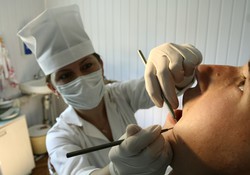Oral health

Nikolai Titov
For further information, contact:
Dr Poul Erik Petersen
WHO/Europe’s oral health programme
WHO Regional Office for Europe
Email: petersenpe@who.int; kiaert@who.int
Oral health is essential to general health and well-being and greatly influences quality of life. It is defined as a state of being free from mouth and facial pain, oral diseases and disorders that limit an individual’s capacity in biting, chewing, smiling, speaking and psychosocial well-being.
Oral diseases in the European Region
Oral diseases are important components of noncommunicable diseases (NCDs), which continue to be a leading public health problem in the WHO European Region. In countries of the European Region, tooth decay among 6-year-old children varies from 20% to 90%. In the age group of 65–74 year-olds, the prevalence of people having lost all their natural teeth ranges from about 20% to 50%. People without natural teeth may have functional problems, which detracts from their quality of life. Oral health problems and access to primary oral health care show very high disparities across Europe.
What are the most frequent oral diseases?
The most frequent oral diseases are:
- dental caries (cavities);
- periodontal (gum) disease;
- oral cancer;
- oral infectious diseases;
- trauma from injuries; and
- hereditary lesions.
Severe oral disease may cause pain and discomfort and often impairs quality of life. In addition, several oral diseases are linked to chronic disease, such as periodontal disease and diabetes, dental caries and obesity. The major diseases afflict people of all ages; they imply loss of school and work hours, and they are a considerable economic burden to the individual and to society. The burden of oral diseases and other chronic diseases in the European Region can be decreased by population-directed prevention which simultaneously addresses the shared risk factors.



